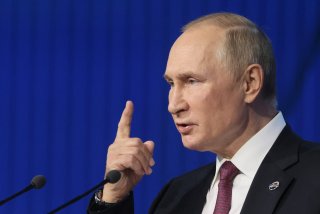‘Shock Therapy’ Laid the Groundwork for Putin and the Ukraine War
If and when the day comes that the West comes to the aid of a post-Putin Russia, let’s hope it will do so more thoughtfully than it did at the end of the Cold War.
Four days after the conclusion of the Beijing Olympics, Vladimir Putin launched his long-premeditated war against Ukraine. As I said at the time, it was an event foreseeable to anyone familiar with Putin’s aspirations of being remembered as a Stalin or Peter the Great, and his pattern of using the Olympic games (see Georgia in 2008 and Crimea in 2014) as a distraction for invasion. Beyond Putin’s goal of remaking the Russian Empire is another long-term cause of the war which has gone largely unmentioned: Russian and Western economists’ disastrous “shock therapy” policies of the 1990s. This approach to remaking the post-Soviet economy produced massive economic disruption inside Russia and created the conditions for Putin to ascend to power in 1999. The Russian and Ukrainian people are still paying the price for the mistakes made by men the West considers economic luminaries—Larry Summers and Jeffrey Sachs among them.
After the collapse of the Soviet Union in 1991, Russian economists like Yegor Gaidar and Anatoly Chubais worked with a cadre of Western advisors to convince Russian president Boris Yeltsin to implement “shock therapy” economic reforms. Their plan to give the Russian economy an immediate capitalist makeover meant, among other things, the rapid privatization of some 15,000 state-run enterprises and the elimination of price controls. It was a disaster for the Russian people. Flipping the switch from a lumbering state-run economy to a capitalist free-for-all produced hyperinflation and severe poverty. NPR has reported that consumer prices in Russia skyrocketed nearly 2,000 percent from 1990 levels; Russia’s per capita income fell by one-third between 1990 and 2000.
I saw the poverty that shock therapy unleashed during my own time living in Russia during the 1990s. As an idealistic college student with a grandfather who had fled the Bolsheviks in 1917 (but who later got to meet Mikhail Gorbachev, bringing his experience with the USSR full circle), I was eager to help Russia become a country of capitalism and democracy. With one year of physics under my belt, I got a job with the U.S. Department of Defense—through Sandia National Labs—to work with Russia’s top scientists. I saw brilliant men and women making just $40 a month, their whole life savings now worthless. At night, I would hail a $5 illegal cab from professionals who needed extra income to make ends meet—and then spend more in a night at Rosie O’Grady’s bar than my scientist colleagues made in a month. I befriended a babushka who was now reduced to cleaning my dormitory after her savings and pension evaporated.
Despite the evident ruin, the Yeltsin administration—with the support of the Clinton administration—stuck to its guns. At the core of the shock therapy effort was the International Monetary Fund and the Harvard Institute for International Development, to which the U.S. Agency for International Development subcontracted its Russia file. Professors like Sachs and Andrei Schleifer teamed up with former Harvard professors Larry Summers and David Lipton, both senior officials at the Department of the Treasury at the time, to advise Gaidar and Chubais. Unlike under the Marshall Plan, the architects of Russia’s transformation refused to give monetary relief while Russia underwent the reforms which the West advised. The result was economic ruin.
Western advice to swiftly privatize Russian state assets also led to a few Russian men taking over entire industries. Poor Russians with little concept of investing or property ownership were issued vouchers for buying stakes in state assets. Desperate for cash, they sold them to a few wealthy buyers. Corruption infested the process of auctioning off massive companies, allowing a generation of oligarchs to bribe their way into ownership of mines, oil refineries, and industrial facilities at cut-rate prices. Norilsk Nickel owner Vladimir Potanin—the wealthiest man in Russia as of October 2022—even became deputy prime minister overseeing economic policy from August 1996 to August 1997.
It wasn’t long before the new masters of the Russian economy threw their political weight around. With the election of 1996 looming, the oligarchs were resolved to keep Yeltsin in power, and they put millions behind his successful re-election effort. Four years later, with Yeltsin’s health faltering, they agreed that a little-known ex-KGB operative would be the leader they could trust to protect their interests. On New Year’s Eve 1999, Yeltsin unexpectedly resigned. Under the Russian constitution, Russia’s relatively new and unknown Prime Minister Vladimir Putin became the acting president, giving him an incumbency advantage in the presidential election held three months later. It also didn’t hurt his chances that Yeltsin spun Clinton in their final phone call by saying of Putin, “I am also sure that he is a democrat.” Clinton, in turn, was reticent to criticize the rickety Russian democratic process over the next few months.
Twenty-two years since Putin came to power, there has been little introspection in the West over shock therapy’s failures, even as the likes of Sachs (a frequent public commentator and advisor to the UN secretary-general) and Summers (a former Treasury secretary and president of Harvard) have gone on to prestigious leadership positions. If and when the day comes that the West comes to the aid of a post-Putin Russia, let’s hope it will do so more thoughtfully than it did at the end of the Cold War.
Maya Joelson is the founder and president of Meta Point Advisors. She lived in Russia during the early 1990s and also worked for the Russian bank Renaissance Capital in London.
Image: Reuters.

